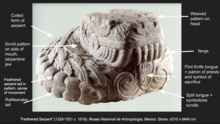Feathered Serpent
The Feathered Serpent was a prominent supernatural entity or deity, found in many Mesoamerican religions. It is still called Quetzalcoatl among the Aztecs, Kukulkan among the Yucatec Maya, and Q'uq'umatz and Tohil among the K'iche' Maya. The real translation is "Precious Holy Snake" or "Precious Holy Twin" with no evidence of this figure having a beard or being European as New Age people have misinterpreted as being the "Jesus of the Americas".
.jpg)
.jpg)
Courtesy of Matt Lachniet, used with permission.


The double symbolism used by the Feathered Serpent is considered allegoric to the dual nature of the deity, where being feathered represents its divine nature or ability to fly to reach the skies and being a serpent represents its human nature or ability to creep on the ground among other animals of the Earth, a dualism very common in Mesoamerican deities.[1]
Description
The earliest representations of feathered serpents appear in the Olmec culture (c. 1400–400 BC). The Olmec culture predates the Maya and the Aztec and once reached from the Gulf of Mexico to Nicaragua. Most surviving representations in Olmec art, such as Monument 19 at La Venta and a painting in the Juxtlahuaca cave (see below), show the Feathered Serpent as a crested rattlesnake, sometimes with feathers covering the body and legs, and often in close proximity to humans.[2] It is believed that Olmec supernatural entities such as the feathered serpent were the forerunners of many later Mesoamerican deities,[3] although experts disagree on the feathered serpent's religious importance to the Olmec.[4]
The pantheon of the people of Teotihuacan (200 BC – 700 AD) also featured a feathered serpent, shown most prominently on the Temple of the Feathered Serpent (dated 150–200 AD).[5] The pyramid was built southeast of the intersection of the avenue of the dead and the east-end avenue. Several feathered serpent representations appear on the building, many of them including full-body profiles and feathered serpent heads. The sculptures utilize practices such as relief carving to create complex ornate compositions. Head carvings of the Feathered Serpent have been frequently found around the Pyramid of the Feathered Serpent.
While the feathered serpent has been a common theme in different Mesoamerican works, it is frequently and most commonly reflected in the architecture of Mesoamerican culture. Some common techniques used to incorporate imagery of the Feathered Serpent into this architecture is relief carving, which involves “a sculpture with figures that protrude from a background while still being attached to it” and normally combined with tenoned heads, which are large pieces of stone carved but have a peg of sorts to insert them into the wall area, adding more depth and details to the architecture. Other Mesoamerican structures, such as the ones in Tula, the capital of the later Toltecs (950–1150 AD), also featured profiles of feathered serpents.[6]
The Aztec feathered serpent deity known as Quetzalcoatl is known from several Aztec codices, such as the Florentine codex, as well as from the records of the Spanish conquistadors. Quetzalcoatl was known as the deity of wind and rain, bringer of knowledge, the inventor of books, and associated with the planet Venus.
The corresponding Mayan god Kukulkan was rare in the Classic era Maya civilization.[7] However, in the Popol Vuh, the K'iche' feathered serpent god Tepeu Q'uq'umatz is the creator of the cosmos.[8]
Along with the feathered serpent deity, several other serpent gods existed in the pantheon of Mesoamerican gods with similar traits, all of which had an important role in the cultural development of Mesoamerican cultures. The proof of the importance of these deities to Mesoamerican culture lies in the architecture left from these civilizations and the rituals surrounding them.
See also
Notes
- The Oxford Encyclopedia of Mesoamerican Culture
- Joralemon, p. 58.
- Covarrubias, p. 62. Joralemon, p. 58.
- Diehl, p. 104 says that "its rarity suggests that it was a minor member of the Olmec pantheon". Joralemon (1996) however, states that "the feathered serpent is a divinity of considerable importance in Olmec civilization", p. 58.
- Castro.
- Coe, p. 133.
- Miller & Taube, p. 150.
- Christenson (2007)
References
- "Marvels of Ancient Mexico" (2018). Blouin Art + Auction, 41(6), 145–146.
- Coe, Michael D.; Rex Koontz (2002). Mexico: from the Olmecs to the Aztecs (5th edition, revised and enlarged ed.). London and New York: Thames & Hudson. ISBN 0-500-28346-X. OCLC 50131575.
- Covarrubias, Miguel (1957). Indian Art of Mexico and Central America (Color plates and line drawings by the author ed.). New York: Alfred A. Knopf. OCLC 171974.
- Christenson, Allen (2007) [2003]. Popol Vuh: the Sacred Book of the Maya. University of Oklahoma Press. ISBN 978-0-8061-3839-8.
- Diehl, Richard (2004). The Olmecs: America's First Civilization. Ancient peoples and places series. London: Thames & Hudson. ISBN 0-500-02119-8. OCLC 56746987.
- Joralemon, Peter David (1996) "In Search of the Olmec Cosmos: Reconstructing the World View of Mexico's First Civilization", in Olmec Art of Ancient Mexico, eds. E. P. Benson and B. de la Fuente, National Gallery of Art, Washington D.C., ISBN 0-89468-250-4, pp. 51–60.
- Miller, Mary; Karl Taube (1993). The Gods and Symbols of Ancient Mexico and the Maya: An Illustrated Dictionary of Mesoamerican Religion. London: Thames & Hudson. ISBN 0-500-05068-6. OCLC 27667317.7
- Pool, Christopher A. (2007). Olmec Archaeology and Early Mesoamerica. Cambridge World Archaeology. Cambridge and New York: Cambridge University Press. ISBN 978-0-521-78882-3. OCLC 68965709.
- Taube, Karl A. "The Teotihuacan Cave of Origin: The Iconography and Architecture of Emergence Mythology in Mesoamerica and the American Southwest", Res: Anthropology and aesthetics 12 (Autumn 1986): 51-82.
Further reading
- Bernal, I; Coe, M; et al. (1973). The Iconography of Middle American sculpture. New York: The Metropolitan Museum of Art. (See index.)
External links
